 |
Top Destinations |
|
|
|
 |
Travel Tools |
|
|
|
 |
|
|
Phuket Attractions - Top Sightseeing and things to see
Each of Phuket's many beaches is blessed with a character and charm very
much of its own. From busy fun beaches offering a range of water sport
activities, to secluded coves of fine white sand backed by verdant hillsides
and visited by little more than the bubbling surf of the Andaman, there
is bound to be at least one to suit the mood and mindset of every visitor
to the island.
|
Patong Beach
|
|
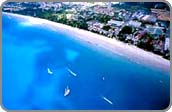
|
(15 km from town)
Phuket's most developed beach offers numerous leisure, sporting,
shopping and recreational options along its 3-km long cresent bay.
Windsurfing, snorkelling, sailing, swimming and sunbathing number
among the many popular daytime activities. Patong is equally well
known for its vibrant nightlife, among which seafood restaurants
feature prominently.
|
|
|
Bangtao Beach
|
|
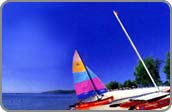 |
Bangtao is a large open bay with one of Phuket's longest beaches.
It was once used for tin mining, but has since been developed into
a luxury resort. Most of it is occupied by the Laguna complex, a
massive five-hotel development with golf course. There are, however,
accommodations available outside Laguna at the bay's south end.
|
|
|
Kata Beach & Karon Beach
|
|
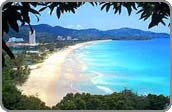 |
Kata Beach (20 & 17 km from town)
Beautiful Kata is a scenic gem, its clear water flanked by hills,
and picturesque Bu island sits offshore. Kata retains a village
feel at its northern and southern ends and is perhaps more family-oriented,
its beach more peaceful than Patong
Karon Beach (20 & 17 km from town)
The second largest of Phuket's tourist beaches. Large resort complexes
line the road behind of the shoreline, but the long, broad beach
itself has no development. The sand is very white, and squeaks audibly
when walked upon. The southern point has a fine coral reef stretching
toward Kata and Bu Island.
|
|
|
Panwa Beach
|
|
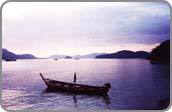 |
(10 km from town)
The southernmost tip of this cape is home to a Marine Biological
Research Centre and Phuket's Aquarium where visitors may inspect
several hundred exotic, grotesque, and flamboyantly colourful marine
species found in the teeming waters of Phuket and elsewhere.
|
|
|
Kamala Beach
|
|
 |
The beach is a favoured spot for witnessing sunsets. The northern
end of Kamala Beach is suitable for swimming.
|
|
|
Pansea Beach
|
|
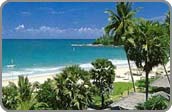 |
(24 km from town)
Pansea is a mouth-wateringly scenic enclave dominated by two deluxe
resorts: Amanpuri and the Chedi. Film stars or VIPs like to stay
there, as they can get away from the crowds. There are just a few
restaurants and shops nearby.
|
|
|
Maikhao Beach
|
|
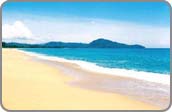 |
(40 km from town)
Many kilometers of deserted beach characterize Mai Khao where there
is little tourist business. The water is fine for swimming during
the dry season; the rainy season brings big waves and strong currents
that are dangerous. This lonely beach is another area where sea
turtles come to lay eggs. It is also home to what the Thais call
a sea cicada, which is a form of marine life. How to get there:
Go to the northern tip of Phuket; the beach lies along the road's
length.
|
|
Coral Island
|
|

|
Koh Hey, off Phuket's south coast, is so well known for its coral
reef that it is often referred to simply as Coral Island. In addition
to the splendid reefs there are two fine beaches on the north and
west of the island.
Koh Hey is part of a marine preserve, but accommodation, restaurants,
various watersports and diving are all available. Boats leave from
Rawai and Chalong. Package tours are also available.
|
|
|
Phi Phi Islands
|
|
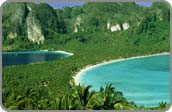 |
Of the two islands, Phi Phi Don is the larger and more developed.
The smaller, Phi Phi Le, recently took the title role in the film
adaptation of The Beach - starring opposite Leonardo Di Caprio.
Despite misinformed protests and bad press regarding environmental
damage to the island during filming, Phi Phi Le is, in fact, in
better condition now than before filming began. International environmentalists
report that the removal of two tons of tourist rubbish before filming
could begin, did not adversely affect the island's delicate ecological
balance.
|
|
|
Similan Islands
|
|
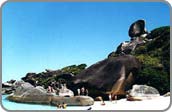 |
From the north to the south, the archipelago comprises Koh Bon,
Koh Ba Ngu, Koh Similan, Koh Payu, Koh Miang (actually two islands),
Koh Payan, Koh Payang, Koh Ku Yong. Except for park officials and
occasional tourist groups, these petite islands are mostly uninhabited.
The waters around the islands are home to a considerable variety
of fish and crustaceans, and other marine life flourishes. The water
in the area is as clear as glass and makes an excellent deep water
dive site.
|
Besides sun, sea and sand, Phuket is a multifaceted destination and offers
ample scope for fascinating exploration. Phuket Town is interesting for
its surviving examples of old Sino-Portuguese architecture - reminders
of the island's long and interesting history - and for its shopping and
entertainment possibilities.
|
Wat Chalong
|
|
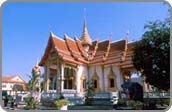
|
This is where stands the cast statue of Luang Por Cham, who helped
the people of Phuket put down the Angyee, or Chinese Coolie Rebellion,
in 1876 during the reign of Rama V. There are also statues of Luang
Por Chaung, and Luang Por Gluam, abbots of the temple during later
times.
How to get there: Wat Chalong is about 8 km outside town. Take
Vichit Songkram Road to the Bypass Road and turn left, and drive
for about 10 mins. Wat Chalong is on the left.
|
|
|
Old Phuket
|
|
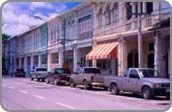 |
The beginning of the tin boom in the 19th century led to construction
of many fine mansions and shops, that are still well preserved.
The architectural style, typical of the region, is described as
Sino-Portuguese and has a strongly Mediterranean chracter. Shops
present a very narrow face onto the street but stretch back a long
way. Many, especially on Dibuk Road, have old wooden doors with
Chinese fretwork carving.
Other streets, forming what might be called "Old Phuket,"
with similar structures are Phangnga, Yaowarat, Thalang, and Krabi,
and a walking tour of the area is easy and delightful. Some other
old European-style buildings of note are the Provincial Hall (Sala
Klang), the Phuket Courthouse (San Changwat), and Nakhon Luang Thai
Bank.
|
|
|
Sapan Hin
|
|
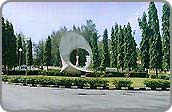 |
A land reclamation project provided abundant new land now used
for parks and public facilities at Sapan Hin, located where Phuket
Road meets the sea in Phuket Town.
In the circle is the Tin Mining Monument, shaped like a large drill
bit, dedicated to the memory of Captain Edward Thomas Miles, the
Australian who brought the first tin dredge to Phuket in 1909.
The monument was built in 1969 on the occasion of the 60th anniversary
of tin dredging in Phuket. A sport center is located in the park.
|
|
|
 |
Travel
Guides |
|
|
 |
|

